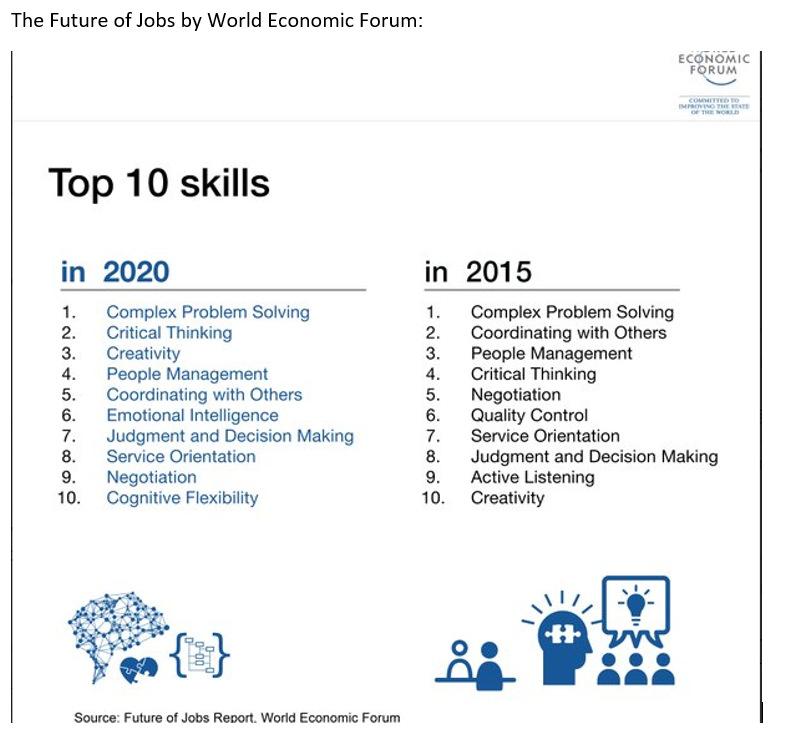Recently, I came across three articles and reports that are describing the future of work:
- The changing world of work, by Microsoft and Poptech
- 9 ways the workplace will be different in 2050, by Business Insider
- The Future of Jobs, by World Economic Forum
Going through each of these reports and drawing all necessary conclusions is a big task. But I would like to see if there are any similarities regarding how our future work and workplaces are described.
Let us start with the first to articles above – the ones from Microsoft/Poptech (left-hand side) and Business Insider (right-hand side). To makes things easier, I simply copied their own descriptions into each square below (they of course have all the credits and copyrights):
| The Changing World of Work “The exponential growth of digital connectivity, devices and information is driving profound changes in the way we work, all around the world. In order to survive in this world, companies need to rethink everything from culture to tools and environments.” |
The corporate ladder could become the “corporate lattice.” “In the past 25 years, one-quarter of companies have reduced the number of layers of management they have, moving toward a flatter, more grid-like management structure.” |
|
| The Responsive Organization “Responsiveness is becoming the key to competitiveness in the ever faster moving and interconnected global economy. To succeed, companies need to shift their focus from efficiency of process to effectiveness of outcomes.” |
Artificial intelligence could replace jobs previously held by humans … “In May, NPR created a digital tool to calculate how likely it is that certain jobs will be taken over by robots 20 years from now. Manual-labor jobs appear to be most at risk, while jobs that require empathy, like social workers and caretakers, are least at risk.” |
|
| Elements of Responsiveness “In pursuit of adaptivity, companies are decentralizing decision-making and empowering their people with information. This increases engagement and enables continuous learning.” |
… but could also create jobs that didn’t exist before. “Canton predicts a scenario in which humans and robots work side-by-side in the future, where new jobs could include operating artificial intelligence-based technology and old jobs could be augmented by it.” |
|
| Working Like a Network “As the world becomes more interconnected, value creation is shifting from the individual to the collective. Resilient, high-empathy teams will drive the best business outcomes.” |
Employers could start recruiting labor from a global pool of freelancers instead of traditional, full-time employees. “It’s cheaper for employers, who have an entire world of workers at their fingertips, to hire freelancers as needed rather than full-time employees, as it doesn’t involve a lengthy hiring process or require them to offer benefits like health insurance or social security.” |
|
| Leadership in Transition “The role of the leader is changing, yet it’s more important than ever. To create adaptive organizations, leaders need to actively shape an open culture that fosters collaboration and builds trust.” |
Retirement could become a thing of the past. “People are living longer, and the cost of living keeps going up, requiring many to keep working much later in life. Younger generations also aren’t saving money for retirement the way their parents’ generation did, because they can’t afford it.” |
|
| The Social Workplace “When you can work from anywhere, why go to the office? Human connections and serendipitous encounters matter more than ever. Modern workplace design needs to be intentionally designed to foster collaboration and tacit knowledge exchange.” |
Workers may demand more of employers, leading to even more career hopping. “A “future of work” report from PricewaterhouseCoopers predicts that people will continue shifting away from the one life, one career mentality — an already observable trend among millennials. Workers will follow their passions as they change, and for many that also means changing careers.” |
|
| A Spectrum of Spaces “Our future workplaces should inspire people to do their best work, both individually and in teams. They will provide a richer variety of spaces to support the full range of human activities and needs.” |
Employees could be monitored, and not just at work. “The PwC report also envisions a world in which employers can monitor and screen their employees at a much more advanced level: “Sensors check their location, performance and health,” the report states. “The monitoring may even stretch into their private lives in an extension of today’s drug tests.”” |
|
| Unlocking Creativity “Automation is changing the nature of our jobs. While many jobs will be eliminated, automation and intelligence will also help us focus our attention on what matters most, create new forms of value, and allow human creativity to flourish.” |
More companies could dissolve traditional offices and headquarters. “Coworking spaces are becoming more and more popular, not just among freelancers and entrepreneurs but also corporations that can use them to relocate employees. Dissolving the traditional office headquarters would enable companies to hire the best candidates all over the world regardless of proximity to a central company hub.” |
|
Driverless cars could make the morning commute faster and easier. “Both Price and Dr. Canton imagine a world in which driverless vehicles could eliminate mass transit and transportation jobs, but on the positive side, these cars could potentially eliminate daily commuter traffic, not to mention crashes and fender benders.” |
Even if their words are different, we see some major things that are supposed to happen:
- The tools we use, ranging from personal tech, via Internet of Things and self-driving cars, will include much more AI than today. Robots and computers can help us do so much more, but also do our work for us. Depending on the outcome, we might do everything from falling in love with them (as in the wonderful movie HER), or feel less valuable since they take our jobs, or invade our privacy.
- Work is what you do – not where you are. This has been a mantra in the Digital Workplace area a few years, and all the above confirms that this is happening. Here, the technology can help us be more free than today, since we carry it with us all the time. Already today, many physical meetings can be replaced by Yammer, Skype or the like. This could also have an effect on the environment, since we travel less. And given that the boundaries of ordinary office work disappears, we feel more creative and can perhaps solve problems in new ways.
- The traditional ways of running companies have soon had its time, it seems. People will get more tired of traditional hierarchies, strict policies, and the long pointless meetings staring at PowerPoint files. Already today, some companies such as Hootsuite and Digital Workplace Group create more virtual teams of experts. There is no point in itself of replicating the ways companies worked in the 1900s.
This leads us to the third outlook on the future: The Future of Jobs by World Economic Forum (see below). Here we see that Creativity is taking a big leap from number 10 to number 3 between 2015 and 2020. Complex Problem Solving is still number one, and might be enhanced by our AI buddies. And given the networked world we seem to be creating, that is where the Emotional Intelligence at place 6 in 2020 might come in: Robots and computers can only do so much the coming years, and we need to build trust to each other even if we don’t meet physically:

If all the above are correct descriptions of what might happen to our work and workplaces, a lot will happen:
- Companies need to be ready to restructure to allow more creative and free flowing work. Some employees might leave since there are networks of people that allow them to work more freely. And they must take care of the workers whose jobs are replaced by machines.
- For us as individuals, we need to handle new skills to survive. We need new methods of learning, such as Personal Knowledge Mastery and Working out Loud. If we are unlucky, we are replaced by machines. If we are lucky, we can avoid the mundane and boring things and focus more on the unique skills that make us human.
I will continue to elaborate on these ideas, and the above is only a start in creating the mental landscape of the future of work. This post by no means covers all the things necessary to take on the future. But is is a start.

One thought on “Three versions of the #futureofwork”